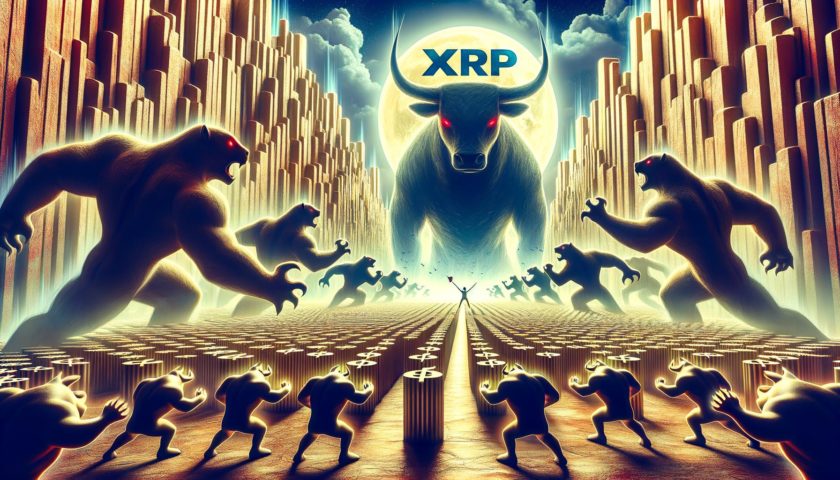Following an enormous drop in Bitcoin’s (BTC) network hash rate back on March 26, the premier currency’s hash rate increased between April 4 and April 6 by at least a whopping 33%, exploding from around 85–91 exahashes per second to roughly 122 EH/s, according to various data sources.
Historically speaking, Bitcoin’s native hash rate and overall price have been linked quite closely, with the two values — up until now — having shown a strong correlation of 0.77. This is because the higher the hash rate, the more expensive it is for a third-party bad actor to take over a network. This virtue of decentralization is one of key aspects that gives Bitcoin its immense value.
With that being said, this time around the aforementioned hash rate spike has failed to produce a substantial rise in Bitcoin’s value, with the flagship crypto asset only rising by a mere 0.95% between April 4 and April 6. Ashu Swami, the chief technology office of digital asset marketplace Apifiny and a former vice president of program trading at Morgan Stanley, told Cointelegraph that, theoretically, Bitcoin’s hash rate has always followed its price because the miner reward quotient is directly proportional to the currency’s value. He added that “there is always a bit of lag,” explaining further:
“In some cases, as in this case, the hashrate can actually recover ahead of the prices because the hashrate had only fallen less than a month ago. The miner inventory was already sitting on the rack and only just powered-off. When BTCs price started rising, mining rigs were immediately turned on. If the gap between those events were longer, it would have involved deracking/racking of the equipment and the hashrate recovery would not be that fast.”
On the subject, Connor Abendschein, a crypto research analyst at Digital Assets Data — a financial technology firm that builds enterprise-grade software — told Cointelegraph that even though it is difficult to determine why specific actors operating within this space do what they do, it’s entirely possible that some prominent miners purposefully dropped the hash rate to lower the mining difficulty so that they could subsequently turn their rigs back online and mine Bitcoin at a faster rate during the current mining cycle.
Abendschein also pointed out that while Bitcoin’s price increase may have not been that huge, the currency’s value has surged by roughly 8% since April 4. Additionally, he opined that there are many factors that affect the price of Bitcoin, with hash rate being only one of the many variables involved. Not only that, he also highlighted that in recent weeks Bitcoin has exhibited strong correlations to a number of traditional equities, something that may have had a substantial effect on the digital currency’s price as well.
A closer look at the matter
In its most basic sense, Bitcoin’s hash rate represents the total computational resources that have been put toward the various mining efforts. On the subject of why Bitcoin’s hash rate dropped during March, Ashish Singhal, the CEO and co-founder of CRUXPay — a decentralized protocol for blockchain naming and payment — told Cointelegraph that the ongoing COVID-19 pandemic is to blame, as it has hit the global economy hard and forced many miners to shut down their operations either entirely or partially.
Singhal also pointed out that China, a nation that accounts for more than 60% of the world’s mining activities, forced the crypto community to reduce their digital footprints during its recent lockdown. In Singhal’s view, another reason for the drop could have been that many miners may have pulled the plug on their day-to-day activities temporarily so as to upgrade and prepare for the Bitcoin halving that is scheduled to take place in May.
Providing insight on the matter, Max Sklar, an engineer for the independent location technology platform Foursquare and the host of The Local Maximum podcast, pointed out to Cointelegraph:
“There’s another side to the equation which is the cost side. In the long term, that’s about investing in the efficient mining machines and deploying them in the right areas, particularly areas with low energy costs. I suspect that the rise in the hashrate we are seeing now is caused in part by miners finding cheaper energy costs during this global crisis and restructuring, combined with the price stabilizing and more efficient hardware being deployed.”
Sklar also stated that contrary to popular belief, it is usually the hash rate that follows the price of Bitcoin and not the other way around. In this regard, he alluded to Bitcoin’s price collapse last month, after which the currency’s hash rate dropped fairly quickly. In his view, this correlation exists because the value of Bitcoin is a very good indicator of miner revenues. He added that “when the hash rate moves independent of Bitcoin’s price, we can conclude that it’s driven by changes in costs and not revenues.”
Speaking on the impact that the COVID-19 pandemic has had on Bitcoin’s hash rate, Igor Runets, the CEO of BitRiver — a co-location services provider for Bitcoin mining in Eastern Europe — told Cointelegraph that he believes this latest spike is largely attributable to the easing of transport and other restrictions in China that were put in place due to the coronavirus outbreak.
The correlation between Bitcoin’s hash rate, its value and miner revenue
When determining the impact a hash rate spike/drop has on the value of Bitcoin and its overall mining revenue, experts believe that a long-term outlook needs to be considered. For example, Runets highlighted that after the price of Bitcoin changes dramatically, people need more time to order, receive and finally plug in their mining rigs.
On the subject, he added that a whole host of mining equipment that was ordered as early as the Chinese New Year in January only made it to its final destinations this week after various transport restrictions that were put in place because of the COVID-19 outbreak in China had been eased.
Jason Wu, the CEO of DeFiner, a blockchain-based lending platform, told Cointelegraph that Bitcoin’s price is a major driver of Bitcoin’s hash rate, and thus any price changes related to Bitcoin tend to have an immediate impact on a miner’s overall revenue. Furthermore, he pointed out that the quantity of Bitcoin per unit cost mined also has a clear impact on miner revenue, adding: “It will have effects that will lag behind around two weeks due to the difficulty adjustment logic. All of this is true for when the difficulty level for mining new blocks is stable.“
However, in times where mining difficulty adjusts significantly, the equation seems to change dramatically because it becomes the main driver for Bitcoin hash rate change. In this situation, miners with less energy-efficient mining machines become gross margin positive. Wu pointed out:
“Miners are required to restart those machines and therefore drive up the BTC hashrate. This is why the recently increased hashrate has not been correlated with a substantial rise in the price of BTC. The rapid increase in hashrate is majorly due to the mining difficulty reduction on March 26th, which occured because of the dramatic BTC price drop that started from two weeks prior to that.”
The road ahead for Bitcoin
As the uncertainty surrounding the global financial sector continues to increase, many experts believe that the crypto industry may be heading toward a Bitcoin bull market, especially as the world’s central banks continue to inflate their existing cash supply streams.
On the subject of where Bitcoin seems to be moving toward in the wake of this latest hash rate increase, Matthew Dibb, the co-founder and chief operating officer of Stack Funds — a provider of Bitcoin trackers and cryptocurrency index funds — told Cointelegraph that having broken the $7,200 handle, Bitcoin will most likely continue on its path to new heights. He added: “This is a sure sign of the resilience of the cryptocurrency industry and the appeal of BTC to investors at this point in time as traditional markets remain highly volatile.”
Dibb also pointed out that Bitcoin’s rising value seems to be in line with its historical cycle, wherein the digital currency trades with an upward momentum of 30% to 50% going into April and May.




